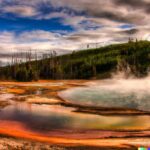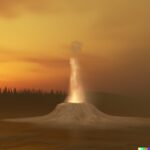Have you ever wondered how those spectacular geysers around the world actually work? From their formation to what triggers their explosive eruptions, the science behind geysers is truly fascinating.
In this article, we will explore the different types of geysers, the factors that cause them to erupt, and how the pressure builds up underground before a dazzling display. So, grab a cup of tea and let’s dive into the mesmerizing world of geyser eruptions!
What Is A Geyser?
A geyser is a fascinating natural phenomenon that showcases the power of geothermal energy through periodic eruptions of hot water and steam.
These eruptions are caused by the underground presence of hydrothermal reservoirs, where water is heated by volcanic activity deep within the Earth’s crust. As the water reaches boiling point, pressure builds up until it eventually explodes out of the ground, leading to the spectacular displays seen in famous geothermal features like Old Faithful in Yellowstone National Park. The connection between geysers and geothermal energy has made them not just a sight to behold, but also a valuable resource for harnessing renewable energy.
How Are Geysers Formed?
Geysers are formed through a complex interplay of factors, including underground water pressure, intense thermal energy, geological processes, and tectonic movements.
When water seeps into the Earth’s crust, it travels deep below the surface and encounters hot rocks or magma chambers. The heat from these geothermal fields warms the water, turning it into steam. As the steam builds up pressure within narrow fissures and channels, it seeks a pathway to escape. When the pressure overcomes the resistance of the overlying water, a sudden eruption results in the spectacular display of a geyser. The geological structures and tectonic activities play a crucial role in maintaining the plumbing system that allows geysers to function.
What Causes A Geyser To Erupt?
The eruption of a geyser is triggered by specific factors such as eruptive behavior, the availability of geothermal resources, external triggers, and careful observations of geyser activity patterns.
These factors play vital roles in understanding the fascinating phenomena of geyser eruptions. Eruptive behavior refers to the pressure buildup within the geyser’s plumbing system, leading to the release of steam and boiling water. The utilization of geothermal resources exemplifies how these natural sources of heat contribute to generating the energy required for eruptions. Identification of eruption triggers involves monitoring temperature fluctuations, seismic activities, and water levels.
Continuous geyser observations are crucial for scientists to gather data for eruption forecasting, helping to predict when the next spectacular display of natural steam explosions might occur.
Heat Source
The heat required for geyser eruptions originates from a variety of sources, including tectonic movements, the presence of hot springs, magma chambers deep within the Earth’s crust, and thermal anomalies within geothermal regions.
These diverse heat sources play crucial roles in fueling the activity of geysers around the world. Tectonic movements, such as the shifting of Earth’s plates, create immense pressure and friction that generate heat underground. Hot springs, often found in geothermal areas, serve as indicators of the intense heat simmering beneath the surface. Magma chambers act as vast reservoirs of molten rock, releasing energy and heating surrounding rock layers. Thermal anomalies within geothermal regions trigger energy transfer processes that contribute to the dynamic nature of geysers. Understanding these geothermal origins is essential for harnessing geothermal technology efficiently.
Water Supply
The availability and circulation of water play a crucial role in geyser eruptions, influenced by hydrogeological conditions, aquifers serving as water reservoirs, geyser observations, and water pressure dynamics within hydrothermal systems.
This interplay of factors highlights the importance of water recharge in sustaining geyser activity. As water infiltrates into the ground, it replenishes aquifers, providing the necessary supply for geyser eruptions. The circulation of groundwater within hydrothermal systems creates a dynamic environment where pressure variations can trigger the spectacular displays seen in geysers. By studying geyser behavior and the underlying hydrogeology, researchers gain valuable insights into the Earth’s subsurface processes and the intricate connectivity between surface water and groundwater resources.
Confinement
The confinement of steam and water within geyser plumbing systems is crucial for building up pressure, with mechanisms like pressure release, specific plumbing structures, distinctive geothermal features, and subsurface pressure conditions playing key roles in eruption dynamics.
When the pressure within a geyser system reaches a critical point, the pressure release mechanism comes into play, causing the iconic eruptions that captivate geothermal enthusiasts worldwide. The intricate plumbing structures of geysers are designed to facilitate the upward movement of water and steam, creating the ideal conditions for a sudden release of energy. These unique geothermal features are a result of a delicate balance between subsurface pressure variations and the containment of intense heat below the Earth’s surface, showcasing the power and beauty of geothermal environments.
What Are The Different Types Of Geysers?
Geysers exhibit diversity in their characteristics, with types such as vapor-dominated geysers, those influenced by precipitation patterns, cascading systems, and subjects of intensive geothermal studies highlighting this variety.
Vapor-dominated geysers, for example, differ from other types by their reliance on high-temperature geothermal fluids that drive their eruptive processes.
On the other hand, geysers dependent on precipitation variations demonstrate how seasonal rainfall can impact their activity, creating a link between external environmental factors and geyser behavior.
Cascading geysers showcase a distinct pattern of multiple eruptions following each other, providing valuable insights into geyser cycles and the intricacies of their operation in geothermal systems.
Fountain Geysers
Fountain geysers are characterized by their eruptive patterns, and understanding them often involves geophysical investigations, analysis of eruption mechanisms, predictive geyser modeling, and accurate eruption forecasting.
Geophysical studies of fountain geysers focus on detecting subtle signals and monitoring geophysical signatures like ground deformation and seismic activity, providing insights into the underlying processes.
Eruption rates play a crucial role in studying these geysers, as they vary depending on factors such as water temperature and underground plumbing systems. By integrating geophysical data with advanced modeling techniques, scientists can simulate geyser behavior and improve eruption predictions, enhancing our understanding of these fascinating natural phenomena.
Cone Geysers
Cone geysers are shaped by geological factors, making them subjects of ongoing research to understand eruption intervals, identify ejecta deposits, and unravel the underlying processes causing their unique cone formations.
Geothermal studies play a crucial role in investigating how the geology influences the cooling processes of cone geysers after eruptions. Recent research efforts have focused on analyzing the timing patterns of geyser eruptions to predict future activity and mitigate potential hazards. By examining the materials ejected during eruptions and studying their compositions, scientists can gain insights into the subsurface dynamics and structural development of these conical formations. Understanding the interplay between geothermal activity and geological structures is essential for comprehensively exploring the formation and behavior of cone geysers.
Fountain-Cone Geysers
Fountain-cone geysers combine aspects of both fountain and cone types, showcasing complex heat transfer processes, distinct geyser features, sporadic geyser occurrences, and intricate eruption dynamics that define their behavior.
These geysers demonstrate a fascinating blend of heat transfer mechanisms, where geothermal heat flux plays a crucial role in propelling their eruptions. The unique characteristics of fountain-cone geysers include their conical formations and intermittent patterns of eruption, making each sighting a captivating experience for geyser enthusiasts. The irregular appearances of these geysers add to their mystique, often surprising researchers with their unpredictability.
By studying geyser observations, scientists gain insights into the dynamic nature of these geothermal features, further unraveling the mysteries of the Earth’s subsurface activities.
Erupting Geysers
Erupting geysers are vital manifestations of geothermal mechanisms, shaped by geothermal gradients, intricate formation processes, and advancements in geothermal technology that aid in understanding their eruptive behaviors.
These geysers provide valuable insights into the intricate interplay of factors such as temperature gradients, underground pressure changes, and eruption triggers. The study of geothermal exploration has significantly benefited from the detailed analysis of geyser eruptions, allowing researchers to understand the underlying geological processes that lead to their spectacular displays.
Technological innovations, such as advanced monitoring systems and remote sensing techniques, have revolutionized the way scientists study these natural phenomena, enabling them to predict eruptions more accurately and enhance overall knowledge of geothermal systems.
How Does The Pressure Build Up In A Geyser?
Pressure buildup within a geyser involves phases such as the steam phase, interaction with distinctive geothermal features, potential steam explosions, and variations observed in geysers worldwide.
When underground water comes into contact with heat from the Earth’s mantle, it gradually rises through fractures and porous rocks, accumulating pressure along the way. As this water reaches the hot rocks near the Earth’s surface, it heats up, causing it to transition into steam. The expanding steam creates immense pressure within the geyser, ultimately propelling the water and steam mixture through the geyser cone when the pressure exceeds the resistance of the overlying water column. This process is crucial in harnessing geothermal resources and understanding the potential hazards associated with geysers, such as steam explosions.
The Superheating Process
The superheating process in geysers is a subject of intense geothermal studies, influencing eruption rates, interactions with hydrothermal vents, and the circulation of groundwater that impacts geyser behavior.
Researchers have delved into the intricacies of superheating to understand the variations in eruption patterns seen in different geyser systems. The connection between superheating and the hydrothermal vent systems is crucial, as it sheds light on the geothermal mechanisms underlying geyser dynamics. Groundwater flow plays a pivotal role in maintaining the thermal energy required for the spectacular eruptions witnessed in these natural wonders. Studying superheating is not only a scientific pursuit but also a way to appreciate the awe-inspiring forces of nature at play in these geological hotspots.
The Steam Phase
During the steam phase of geyser activity, various eruption mechanisms come into play, influenced by geyser mechanics, triggering events, and subsequent cooling processes that regulate the geyser’s behavior.
The steam phase marks a critical stage in the geyser eruption cycle, as the intense build-up of pressure within the geyser chamber results in the forceful expulsion of superheated water and steam. This phase is driven by the interplay between water temperature and pressure underground, creating a delicate balance that ultimately leads to the dramatic eruption. Understanding the dynamics of steam expansion and release during this phase provides insights into the inner workings of geysers and the factors that drive their spectacular displays of natural power.
The Water Phase
The water phase of geyser eruptions showcases distinct geophysical signatures, varying eruption frequencies, underlying formation processes, and contributions to ongoing geothermal studies investigating geyser phenomena.
These geophysical signatures play a crucial role in understanding the cyclical nature of geyser activity, known as geyser cycles. By observing the patterns of eruption frequencies, scientists can decipher the intricate mechanisms that govern these spectacular natural phenomena.
Water, as the primary agent in geyser eruptions, holds significant importance in geothermal studies aiming to unravel the dynamics of geyser behavior. Through in-depth investigations of geyser dynamics, researchers can unveil valuable insights into the Earth’s subsurface processes and the intricate relationship between water and geothermal activity.
The Steam Explosion
The steam explosion phase in geyser eruptions is governed by specific eruption mechanisms, influencing eruption rates, reflecting geothermal origins, and showcasing the transfer of geothermal heat flux in geyser activities.
During this explosive stage, the mixture of water and steam reaches extreme temperatures beneath the earth’s surface, creating immense pressure that eventually leads to the rapid expansion of steam. This expansion, triggered by the heat transfer from the underlying geothermal reservoir to the geyser conduit, results in the forceful eruption of boiling water and steam. The variations in eruption rates observed among different geysers can be attributed to the unique geothermal settings and the intricate interplay of subsurface geological features. Understanding these geothermal processes is vital for harnessing the energy potential offered by geyser systems and advancing geothermal technology.
What Factors Affect The Frequency And Duration Of Geyser Eruptions?
The frequency and duration of geyser eruptions are influenced by various factors such as geyser activity levels, specific eruption triggers, geophysical conditions, and distinct eruption patterns observed in geyser behavior.
Geyser observations show that the intervals between eruptions can vary significantly, with some geysers erupting regularly at set intervals while others display more irregular patterns. These eruption intervals are often linked to the depth at which the water reservoir is located underground, as deeper reservoirs may take longer to heat up and reach boiling point, affecting both the frequency and duration of eruptions. Geophysical influences like seismic activity and underground hydrothermal systems also play a role in modulating geyser behavior, further contributing to the complexity of eruption dynamics.
Water Supply
The water supply to geysers, facilitated by hydrothermal fluids, plays a critical role in eruption dynamics, driven by underlying geothermal mechanisms and the transfer of geothermal heat flux that shapes the geyser behavior.
Understanding the interplay between the replenishment of water in geysers and the underlying geothermal processes is key to geyser research. Researchers delve into the complexities of geyser features, such as eruption frequency, height, and duration, to unravel the intricate dynamics of eruptive events. The intricate balance between the influx of hydrothermal fluids and the release of pressure builds up within the geothermal systems, ultimately culminating in the breathtaking displays of geyser eruptions witnessed in various geothermal regions around the world.
Confinement
Confinement mechanisms within geyser systems regulate the development of geysers, influencing cyclic behaviors, repetitive geyser cycles, and serving as subjects of extensive geothermal studies to understand these natural phenomena.
These confinement structures play a crucial role in controlling the eruption rates of geysers, as they trap and build up pressure within the underground chambers, leading to the periodic and dramatic releases of steam and hot water.
By studying the geothermal environments surrounding these geyser systems, researchers can gain insights into the geological, hydrological, and thermal dynamics that contribute to the mesmerizing displays of geysers.
Understanding the complexities of geyser behavior not only adds to our knowledge of Earth’s natural processes but also aids in predicting and monitoring potential geothermal hazards.
Heat Source
The heat source influencing geyser activities is rooted in aspects such as geysers formation processes, geothermal gradients, ongoing geothermal exploration efforts, and the hydrogeological characteristics shaping the thermal dynamics of geyser systems.
These factors collectively play a crucial role in determining the behavior of geysers worldwide. Geothermal resources, which are key in the activation of geysers, are dependent on the underlying heat flow from the Earth’s mantle. Temperature gradients within geyser environments create the conditions necessary for the eruption of hot water and steam.
Observations of geyser eruptions provide valuable insights into the geological forces at work beneath the surface. Understanding the intricate relationship between these factors is essential for harnessing geothermal energy sustainably and effectively.
Tectonic Activity
Tectonic activity shapes geyser phenomena through the prism of geothermal theory, influencing eruption intervals, driving ongoing geysers research endeavors, and serving as potential eruption triggers in the intricate mechanisms governing geyser behavior.
These tectonic movements play a crucial role in the periodicity of geyser eruptions, influencing both the frequency and intensity of these spectacular natural events. By examining the theoretical frameworks that underpin geyser dynamics, scientists can enhance their understanding of the intricate relationship between tectonic forces and volcanic activity.
Recent advancements in geothermal studies have shed new light on the underlying processes that govern geyser eruptions, providing valuable insights into the factors that regulate eruption timing patterns. Understanding the role of tectonic triggers is essential in deciphering the complex interplay of geological forces that contribute to the mesmerizing spectacle of geyser eruptions.
Last Updated on February 7, 2024 by Jon Waraas – Originally Posted: February 7, 2024

I’m Jon Waraas, and I’ve been navigating the online world since 2006. By day, I’m the proud owner of some eCommerce gems, and by night, I’m the voice behind the adventures on Waraas.Com.
My heart, however, belongs to the wild beauty of Yellowstone National Park. I’ve got a collection of websites dedicated to sharing the wonders of this natural masterpiece. Oh, and did I mention? I’m currently building my own cabin inside the ghost town of Gilmore, Idaho – a cabin with tales to tell!
When I’m not immersed in the digital realm, you’ll find me lacing up my boots for a good hike or setting up camp under the star-studded sky.




